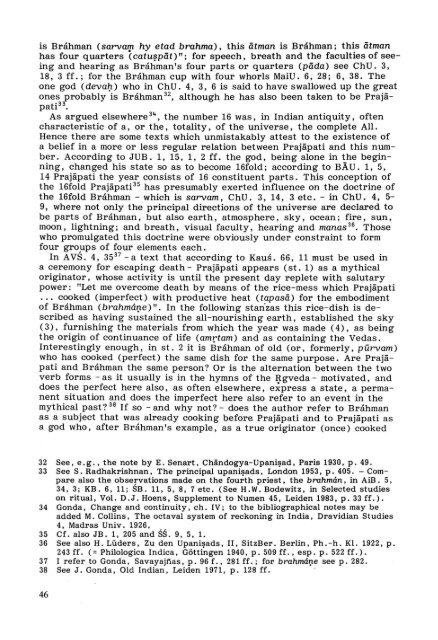Prajapati's relations with Brahman, Brhaspati and Brahma - DWC
Prajapati's relations with Brahman, Brhaspati and Brahma - DWC
Prajapati's relations with Brahman, Brhaspati and Brahma - DWC
You also want an ePaper? Increase the reach of your titles
YUMPU automatically turns print PDFs into web optimized ePapers that Google loves.
is Bráhman (sarvam hy etad brahma), this ätman is Bráhman; this ätman<br />
has four q uarters (catu~pät)"; for speech, breath <strong>and</strong> the faculties of seeing<br />
<strong>and</strong> hearing as Bráhman's four parts or quarters (päda) see ChU. 3,<br />
18, 3 ff.; for the Bráhman cup <strong>with</strong> four whorls MaiU. 6, 28; 6, 38. The<br />
one god (deva~) who in ChU. 4, 3, 6 is said to have swallowed up the great<br />
ones probably is Bráhman 32, although he has also been taken to be Prajäpati<br />
33 •<br />
As argued elsewhere 3 '+, the number 16 was, in Indian antiquity, often<br />
characteristic of a, or the, totality, of the universe , the complete All.<br />
Hence there are some texts which unmistakably attest to the existence of<br />
a belief in a more or less regular relation bet ween Prajäpati <strong>and</strong> this number.<br />
According to JUB. 1, 15, 1, 2 ff. the god, being alone in the beginning<br />
, changed his state so as to become 16fold; according to BÄ U. 1, 5,<br />
14 Prajäpati the year consists of 16 constituent parts. This conception of<br />
the 16fold Prajäpati 35 has presumably exerted influence on the doctrine of<br />
the 16fold Bráhman - which is sarvam, ChU. 3,14,3 etc. - in ChU. 4, 5-<br />
9, where not only the principal directions of the universe are declared to<br />
be parts of Bráhman, but also earth, atmosphere, sky, ocean; fire, sun,<br />
moon, lightning; <strong>and</strong> breath, visual faculty, hearing <strong>and</strong> manas 36. Those<br />
who promulgated this doctrine were obviously under constraint to form<br />
four groups of four elements each.<br />
In A VS. 4, 35 37 - a text that according to Raus. 66, 11 must be used in<br />
a ceremony for escaping death - Prajäpati appears (st. 1) as a mythical<br />
originator, whose activity is until the present day replete <strong>with</strong> salutary<br />
power: "Let me overcome death by means of the rice-mess which Prajäpati<br />
... cooked (imperfect) <strong>with</strong> productive heat (tapasä) for the embodiment<br />
of Bráhman (brahmá1)e)". In the following stanzas this rice-dish is described<br />
as having sustained the all-nourishing earth, established the sky<br />
(3), furnishing the materials from which the year was made (4), as being<br />
the origin of continuance of life (amrtam) <strong>and</strong> as containing the Vedas.<br />
Interestingly enough, in st. 2 it is Bráhman of old (or, formerly, purvam)<br />
who has cooked (perfect) the same dish for the same purpose . Are prajäpati<br />
<strong>and</strong> Bráhman the same person? Or is the alternation bet ween the two<br />
verb forms - as it usually is in the hymns of the ~gveda - motivated, <strong>and</strong><br />
does the perfect here also, as often elsewhere, express a state, a permanent<br />
situation <strong>and</strong> does the imperfect here also refer to an event in the<br />
mythical past? 38 If so - <strong>and</strong> why not? - does the author refer to Bráhman<br />
as a subject that was already cooking before Prajäpati <strong>and</strong> to Prajäpati as<br />
a god who, after Bráhman 's example, as a true originator (once) cooked<br />
32 See, e.g., the note by E. Senart, Chändogya-Upani!?ad, Paris 1930, p. 49.<br />
33 See S. Radhakrishnan, The principal upani!?ads, London 1953, p. 405. - Compare<br />
also the observations made on the fourth priest, the brahmán, in AiB. 5,<br />
34,3; KB. 6, 11; SB. 11,5,8,7 etc. (See H.W. Bodewitz, in Selected studies<br />
on ritual, Vol. D.J. Hoens, Supplement to Numen 45, Leiden 1983, p. 33 ff.).<br />
34 Gonda, Change <strong>and</strong> continuity, ch. IV; to the bibliographical notes may be<br />
added M. Collins, The octaval system of reckoning in India, Dravidian Studies<br />
4, Madras Univ. 1926,<br />
35 Cf. also JB. 1, 205 <strong>and</strong> SS. 9, 5, l.<br />
36 See also H. Lüders, Zu den Upani!?ads, 11, SitzBer. Berlin, Ph.-h. Kl. 1922, p.<br />
243 ff. (= Philologica Indica, Göttingen 1940, p. 509 ff. , esp. p. 522 ff. ) .<br />
37 I refer to Gonda, Savayajfias, p. 96 f., 281 ff.; for brahmá~e see p. 282.<br />
38 See J. Gonda, Old Indian, Leiden 1971, p. 128 ff.<br />
46
















